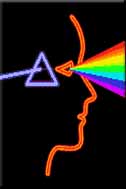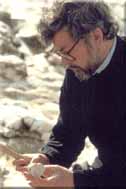|
|
| Not unlike the experience of travelling to little visited far flung corners of the earth and finding surprisingly similar myths describing origins of local culture; we find ourselves filled with a similar wonder upon travelling to little visited academic sub-disciplines. Just as two world apart aboriginal cultures might have no contact with each other, the heterochronic practitioners of evolutionary biology have little traffic with the neuropsychological theorists that may be located less than a hundred yards away in another building on the same campus. Strangely, we find these different scientists discussing identical processes in different languages with almost no published awareness that this might be the case.
How might two different scientific disciplines be discussing the same natural dynamic and not know it, not unlike two aboriginal societies fearing menstrual blood half a world apart, unaware of another culture with the same belief? The followers of heterochronic theory, tucked within the discipline of evolutionary biology, follow the influence of the relative rate and timing of development and maturation on species transformation. These theorists believe they have discovered a shortcut in the process by which Darwin's selective processes, natural selection and sexual selection, cajole and curtail the way species transform and metamorphosize. The concept is elegant. Instead of waiting for chance mutations or unusual random variations with selective processes acting to retain specific useful features; a simple single gene variation in, for example, the speed an individual can reach maturity, could mean that this faster growing individual can defend his or herself against a threat that another slower developing individual might bow down to. Passing on this ability to grow faster, this individual's progeny would also have an increased chance to survive. This is one of several ways of manipulating the development and maturation process. Growing smaller is an advantage in many situations, as is growing slower. For example, spending more time at a specific maturational stage, the stage where brain size increases are at their most intense, might result in a far larger brain when that individual reaches adulthood. By having a more prolonged early infancy, some species might attain a larger brain size. All that changed may have been the rate of maturation at a specific age for a specific or extended period of time. Stephen J. Gould suggests that prolonging the stages of infant growth into adulthood, since our divergence from chimpanzee like ancestors 5 million years ago, would result in many features we identify as human. Human adults look look like chimpanzee infants, in this case a human's ancestral infant stage prolonging its features into its descendant's adulthood. It is the rates and timing of maturation that lead to an understanding of how humans evolved. So how do rate and timing changes in hominid evolution relate to the studies of neuropsychologists? Evolution is not just a record of the processes of the past leading to the present. Evolution is the process by which life unfolds in the here and now. The biggest block to understanding the connection between these two disciplines is the belief by many evolutionary theorists that the genes you pass onto your progeny cannot be revised once you have been conceived. The confusion has to do with belief that our genes are randomly delt according to a randomly created sperm, impregnating a egg randomly created by the female's parents. Overlooked, is that long, long ago, embryo's and animals were genetically programmed, naturally selected, to respond to changes in their environment, passing on these changes to their progeny in a form that their progeny could revise the rate and timing of their development and maturation to conform with what their parent's body's had learned. Changes in diet influence the onset of puberty. Puberty has been dropping for 100 years. Teens start their changes 3 to 4 years earlier than they did 100 years ago. It has been suggested that increased high fat diets trigger earlier puberty generating a change in the body's environment that gets communicated to the next generation genetically, when eggs and sperm are produced. Egg and sperm are produced from the body's hormonal constellation at the time of egg and sperm creation; for the woman when she herself was an embryo, for the man at the time of sperm creation within days of ejaculation. The parent's body knows hormonally there has been an increase in the fat content of the diet. The message is passed on through genes that were naturally selected to be able to discriminate hormonal changes. It is an important message. It is a message that, over the course of several generations, can mean a huge difference in the number of descendants walking the globe. Early puberty means early procreation. A message that higher fat reserves exist, lowering puberty, increases the potential for more offspring to take advantage of the increased resources. Puberty has been dropping for 100 years as each generation passes to the next the fact that those resources still exist. This is evolution in the here and now -- individuals making it possible for their progeny to flourish in a changing environment, creating progeny prepared for the specific world they are entering. We pass on the information that clues our children into appropriate maturation rate based on how our hormonal systems fluctuate to the environment we live in. It is our hormonal systems that create the egg, the sperm, and the uterine environment that guide our children to a fertile adulthood. Many neurological conditions and diseases are a direct result of hormonal messages guiding the rate and timing of development and maturation of individuals for environments not currently useful for survival. Extremely developmentally delayed individuals can end up autistic. Heterochonic theorists and neuropsychologists are both describing the effects of environments on the rate and timing of maturation. Both are describing the identical processes. Neurophychologists see the effects of rate and timing changes on a time scale of the present --fast time. Evolutionary biologists have difficulty speeding up enough to see it. Without the perspective across time -- slow time -- characteristic of an evolutionary biological point of view, neuropsychologists behave unaware that a disease may have a evolutionary foundation. In both cases, because non-random changes can lead to single generation changes, theorists trained to note only random changes do not see it. Ancient peoples across the planet may have myths grounded in a magic we are only starting to understand. Scientists in different disciplines may be actually exploring the same aboriginal territory, unaware that they have colleagues mere feet away, in the very same jungle. -Andrew Lehman |
|
Home | Arts | Comics | Culture | Music | Science | Spirituality
|
|
Alternative science: Forgotten theories, rejected theories, cutting edge theories, non-science theories and paradigm busters. |












